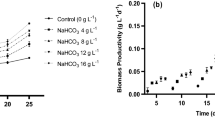Summary
In a naked clone of the coccolithophorid Coccolithus huxleyi, growth at light saturation was 15% slower than in a coccolith-forming clone isolated from the same parent stock. The two cell types did not differ significantly with regard to cell volume and protein content. A 10–13% smaller chlorophyll a content of the naked cells was matched by a uniform lowering of photosynthetic rates at all light intensities. It was considered that the slower growth of these cells might result from a less favourable ratio between photosynthetic output and biomass.
The content of deoxyribonucleic acid was the same in coccolith-forming and naked cells, suggesting that they do not represent different phases in a sexual lifecycle.
Similar content being viewed by others
References
Braarud, T., Gaarder, K. R., Markali, J., Nordli, E.: Coccolithophorids studied in the electron microscope. Nytt Mag. Bot. 1, 129–134 (1952).
Coombs, J., Lauritis, J. A., Darley, W. M., Volcani, B. E.: Studies on the biochemistry and fine structure of silica shell formation in diatoms. VI. Fine structure of colchicine-induced polyploids of Navicula pelliculosa (Breb.) Hilse. Z. Pflanzenphysiol. 59, 274–284 (1968).
Darley, W. M.: Deoxyribonucleic acid content of the three cell types of Phaeodactylum tricornutum Bohlin. J. Phycol. 4, 219–220 (1968).
Eppley, R. W., Holmes, R. W., Strickland, J. D. H.: Sinking rates of marine phytoplankton measured with a fluorometer. J. exp. mar. Biol. Ecol. 1, 191–208 (1967).
—: Growth rates of marine phytoplankton: correlation with light absorption by cell chlorophyll a. Physiol. Plant. (Copenh.) 19, 47–59 (1966).
Holm-Hansen, O., Sutcliffe, W. H., Jr., Sharp, J.: Measurement of deoxyribonucleic acid in the ocean and its ecological significance. Limnol. Oceanogr. 13, 507–514 (1968).
Lind, O. T., Campbell, R. S.: Comments on the use of liquid scintillation for routine determination of 14C activity in production studies. Limnol. Oceanogr. 14, 787–789 (1969).
Lohmann, H.: Über Coccolithophoriden. Verh. dtsch. zool. Ges. 23, 143–164 (1913).
Lowry, O. H., Rosebrough, N. J., Farr, A. L., Randall, R. J.: Protein measurement with the Folin phenol reagent. J. biol. Chem. 193, 265–275 (1951).
Manton, I., Leedale, G. F.: Observations on the microanatomy of Coccolithus pelagicus and Cricosphaera carterae, with special reference to the origin and nature of coccoliths and scales. J. mar. biol. Ass. U. K. 49, 1–16 (1969).
Mjaaland, G.: Some laboratory experiments on the coccolithophorid Coccolithus huxleyi. Oikos 7, 251–255 (1956).
Paasche, E.: The adaptation of the carbon-14 method for the measurement of coccolith production in Coccolithus huxleyi. Physiol. Plant. (Copenh.) 16, 186–200 (1963).
—: A tracer study of the inorganic carbon uptake during coccolith formation and photosynthesis in the coccolithophorid Coccolithus huxleyi. Physiol. Plant. (Copenh.) Suppl. 3, 1–82 (1964).
—: Action spectrum of coccolith formation. Physiol. Plant. (Copenh.) 19, 770–779 (1966).
—: Marine plankton algae grown with light-dark cycles. I. Coccolithus huxleyi. Physiol. Plant. (Copenh.) 20, 946–956 (1967).
—: Biology and physiology of coccolithophorids. Ann. Rev. Microbiol. 22, 71–86 (1968).
—: Light-dependent coccolith formation in the two forms of Coccolithus pelagicus. Arch. Mikrobiol. 67, 199–208 (1969).
Parke, M., Adams, I.: The motile (Crystallolithus hyalinus Gaarder & Markali) and non-motile phases in the life history of Coccolithus pelagicus (Wallich) Schiller. J. mar. biol. Ass. U. K. 39, 263–274 (1960).
Price, C. A.: A membrane method for determination of total protein in dilute algal suspensions. Analyt. Biochem. 12, 213–218 (1965).
Rayns, D. G.: Alternation of generations in a coccolithophorid, Cricosphaera carterae (Braarud & Fagerl.) Braarud. J. mar. biol. Ass. U. K. 42, 481–484 (1962).
Sheldon, R. W., Parsons, T. R.: A practical manual on the use of the Coulter Counter in marine research. Toronto: Coulter Electronics Sales Co. 1967.
Steemann Nielsen, E.: The uptake of free CO2 and HCO3 - during photosynthesis of plankton algae with special reference to the coccolithophorid Coccolithus huxleyi. Physiol. Plant. (Copenh.) 19, 232–240 (1966).
Strickland, J. D. H., Parsons, T. R.: A practical handbook of seawater analysis. Bull. Fish. Res. Bd Can. 167, 1–311 (1968).
Talling, J. F.: Photosynthetic characteristics of some freshwater plankton diatoms in relation to underwater radiation. New Phytol. 56, 29–50 (1957).
Wilbur, K. M., Watabe, N.: Experimental studies on calcification in molluses and the alga Coccolithus huxleyi. Ann. N. Y. Acad. Sci. 109, 82–112 (1963).
Author information
Authors and Affiliations
Rights and permissions
About this article
Cite this article
Paasche, E., Klaveness, D. A physiological comparison of coccolith-forming and naked cells of Coccolithus huxleyi . Archiv. Mikrobiol. 73, 143–152 (1970). https://doi.org/10.1007/BF00410317
Received:
Issue Date:
DOI: https://doi.org/10.1007/BF00410317




